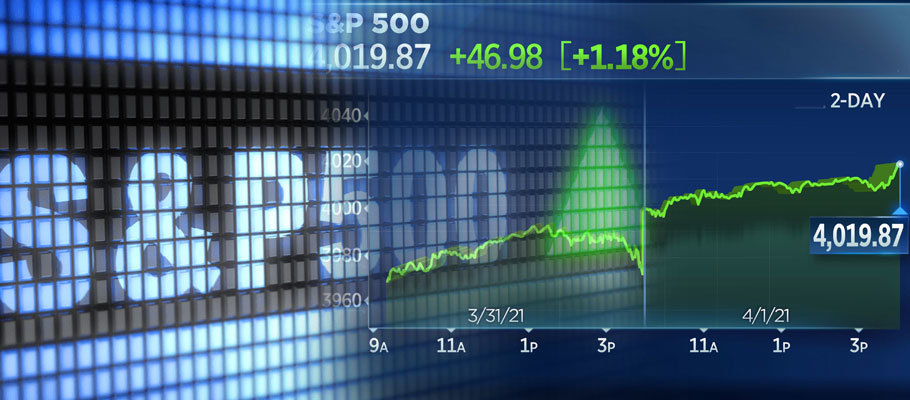
Published: April 5th, 2021
On Thursday, April 1, the S&P 500 index surpassed the 4,000-point milestone for the first time. The milestone came as Wall Street recorded an impressive rally following the rollout of the elaborate infrastructure plan fronted by President Joe Biden’s administration.
The S&P 500 index rose to a record milestone on Thursday, April 1, dashing past 4,000 points for the first time. The rally comes on the backdrop of the rollout of the elaborate infrastructure plan fronted by President Joe Biden.
The broad equity gauge swelled by 1.2% to etch a new record close of almost 4,100. Meanwhile, the Dow Jones Industrial Average gained 171.66 points, about 0.5%, to close the day at 33,153.21. The increase was not limited to just the two indexes. The Nasdaq Composite picked almost 2% to push the tech-heavy index to 13,480.11.
Individual equities that influenced the day included Netflix and Alphabet, which rose by more than 3% each. Amazon and Microsoft also went up by more than 2%. Microsoft shares shot up after news reached the market that the software giant would supply the U.S. Army with more than 120,000 HoloLens augmented reality (AR) handset devices. The Microsoft contract is worth almost $22 billion spread over 10 years.
Overall, the tech stocks led the surge that also saw the bond yields steadily recede from the recent highs. The 10-year Treasury yield contracted by 7 basis points to 1.68% on Thursday, April 1. the benchmark rate attained a 14-month high of 1.77% during the week that ended on Saturday, March 27.
The swell experienced in stocks began soon after the Biden administration introduced its multi-trillion-dollar infrastructure plan. The proposal advocates for increased spending on roads, bridges, water systems upgrades, and green energy. It is the second major spending instigated by the new president’s administration after the $1.9 trillion coronavirus relief and economic stimulus bill that he signed on March 11.
According to Craig Johnson, the technical market strategist at Piper Sandler, reopening the U.S. economy would continue to support equities markets as hope over coronavirus grows louder. Besides, the support that monetary and fiscal policies offer is still unprecedented and well in tune with the factored growth, Johnson added.
The plan that President Biden introduced on Wednesday, March 31, carries about $2 trillion in spending spread over almost a decade.
Much of the plan would be funded by corporate tax, which the Biden administration has proposed to increase to 28%. Despite the rally on Wall Street, some investors are afraid that increasing corporate taxes would threaten the recovering stock prices and corporate earnings.
Savita Subramanian, an equity strategist at the Bank of America, said that the market might take some time to understand the tax increases incorporated in the proposal. According to her, the longer the market takes, the longer the headwind it might create for stocks.
Speaking to CNBC’s Fast Money, the senior executive at one of America’s most respected banks, said that right now, the markets are concentrating only on the good aspects of the plan. When the economy and the equity markets start factoring in the negative aspects, the situation will get a little heated, and that is how the markets will pay for the adjustments, she added.
Meanwhile, the U.S. manufacturing sector index also surged. According to the Institute of Supply Management (ISM), the index of national factory activity jumped from 60.8 in February to 64.7 in March, its highest level since December 1983.
Any reading above 50% usually is an indication of expanding manufacturing activity. Considering that the economic activity accounts for 11.9% of the U.S. economy, these latest figures are further testimony that the U.S. economy is on a steady path to full recovery.
Despite the many positives, a cross-section of investors is worried about the worse-than-expected weekly jobless claims report. For the week that ended on Saturday, March 27, the first-time claims for unemployment insurance shot to 719,000, far more than the 675,000 figure that economists surveyed by Dow Jones had predicted.
The harsh figures notwithstanding, nonfarm payrolls increased by almost 920,000 in March, taking the overall unemployment rate to 6%. The March figures are the fastest since August 2020. The leisure and hospitality industry recorded the most gains. Construction was second with 110,000 new jobs.
Revisions conducted on the January and February numbers also added another 156,000 jobs. An aggressive vaccination effort coupled with stronger economic growth is responsible for the boom.
The chief market strategist at Prudential Financial, Quincy Krosby, said the huge rise is a result of a healing economy, meaning that people who lost their jobs are now coming back. Krosby said the decrease in the unemployment rate will continue as long as recovery stays on course and the coronavirus restrictions are lifted. He added that the only concern now is if the country experiences another wave of fresh COVID-19 infections that culminate in another episode of closures.
Rumors of deals in the market suggest that Micron Technology and Western Digital are working on a proposal to buy Kioxia, a Japanese semiconductor manufacturer. News of the deal said to be about $30 billion, pushed Micron shares up by 4% while Western Digital swelled by 6.9%.
Overall, Wall Street closed March with impressive gains. The Dow ended up 6.6% while the S&P 500 increased by 4.3%. These are the best results since November. However, the Nasdaq was not as robust, picking only 0.4% during the month. The tech-heavy index was affected by the many tech stocks that came under pressure because of the rising interest rates.
The S&P 500 index dashed past 4,000 points for the first time. The index’s impressive performance that took it past the milestone is a result of the elaborate spending proposal that President Joe Biden has fronted. The president’s proposal advocates for the spending of about $2 trillion on infrastructure development. Much of the funding for this huge plan will come from increasing corporate taxes.